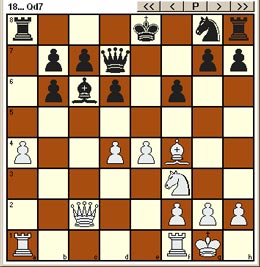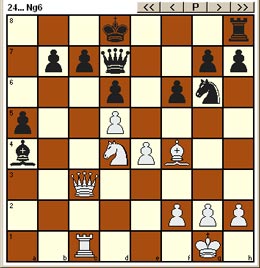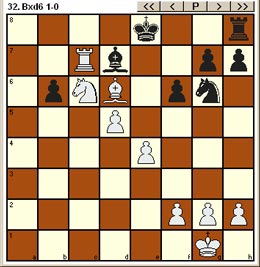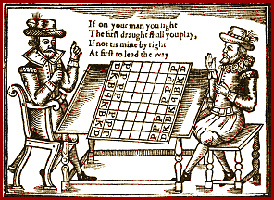Dadian of Mingrelia, Prince -- Solovtsov,
Alexander V
Saint Petersburg, Russia 1885
(Notes by Wilhelm Steinitz)
The following instructive game was
recently played, at St. Petersburg, between Prince Dadian of
Mingrelia
and Mr. Solovtzov (Alexander Vladimirovich Solovtsov), two of the
strongest Russian amateurs.
1.e4 e5 2.Nf3 Nc6 3.Bc4 Bc5 4.b4 Bxb4 5.c3 Ba5 6.O-O Bb6
-
 The Prince of Mingrelia informs us that in reply to
the usual defense recommended here, viz., 6...Nf6 , he intended
the following new continuation: 7.d4 O-O 8.dxe5 Nxe4 9.Qd5 Nxc3
10.Qd3 Our correspondent does not proceed further with this
variation which we have never seen analyzed. We must confess that
we fail to understand how White will make the attack pay for the
two pawns lost, if Black simply plays 10...Nxb1 11.Ng5
If, however, 11.Rxb1 d6 12.Ba3 Re8 and White (sic Black)
ought to keep at least one pawn ahead. 11...g6 12.Qh3 h5
The Prince of Mingrelia informs us that in reply to
the usual defense recommended here, viz., 6...Nf6 , he intended
the following new continuation: 7.d4 O-O 8.dxe5 Nxe4 9.Qd5 Nxc3
10.Qd3 Our correspondent does not proceed further with this
variation which we have never seen analyzed. We must confess that
we fail to understand how White will make the attack pay for the
two pawns lost, if Black simply plays 10...Nxb1 11.Ng5
If, however, 11.Rxb1 d6 12.Ba3 Re8 and White (sic Black)
ought to keep at least one pawn ahead. 11...g6 12.Qh3 h5
7.d4 exd4 8.cxd4 d6 9.Nc3 Na5 10.Bg5 f6 11.Bf4 Nxc4 12.Qa4+ Qd7 13.
Qxc4 Qf7 14.Nd5 Be6 15.Qa4+ Bd7
-
 If 15...Qd7 there may follow: 16.Nxb6 cxb6 17.Qxd7+ Kxd7 18.d5 Bg4
19.Nd4 and if Black now play 19...a6 in order to prevent the
entrance of the knight at Kt5 threatening Kt x P, then White will
nevertheless recover his Pawn with a good game by 20.f3 followed by Nf5 or
even Ne6
If 15...Qd7 there may follow: 16.Nxb6 cxb6 17.Qxd7+ Kxd7 18.d5 Bg4
19.Nd4 and if Black now play 19...a6 in order to prevent the
entrance of the knight at Kt5 threatening Kt x P, then White will
nevertheless recover his Pawn with a good game by 20.f3 followed by Nf5 or
even Ne6
16.Qc2
- So far the game has followed the track of one played
between Tschigorin and Steinitz in the London tournament of 1883. The
former, however, played 16.Qa3 at this point.
16...Bc6 17.Nxb6 axb6 18.a4 Qd7
-
 This hampers Black's game for a long time. 18...Rc8 was the proper move. If, however, 18...Ra5 19.d5
Rc5 20.dxc6 Rxc2 21.cxb7 and wins
This hampers Black's game for a long time. 18...Rc8 was the proper move. If, however, 18...Ra5 19.d5
Rc5 20.dxc6 Rxc2 21.cxb7 and wins
19.Rfc1
-
An excellent rejoinder which gives White a powerful attack.
19...Kd8
-
Black has an uncomfortable game, but under the circumstances his
best defense was as follows:
- 19...Ne7 20.d5 Bxa4 21.Qxc7 Kf7 , etc
20.a5
-
Well played. It was worth a Pawn to black the adverse Rook or to
get rid of it by exchanging
20...Rxa5
- If 20...bxa5 : the game might have continued thus: 21.d5 Bb5
22.Nd4 Rc8 23.Rxa5 Ba6 24.Ne6+ Ke8 25.Qxc7 Rxc7 26.Rxc7 , with even
pawns and an excellent game.
21.Rxa5 bxa5 22.d5 Ba4 23.Qc3 Ne7 24.Nd4 Ng6
-
 With two pawns ahead, Black has very little choice of defensive
measures. Had he advanced the QBP, the game might have have gone
on thus:
With two pawns ahead, Black has very little choice of defensive
measures. Had he advanced the QBP, the game might have have gone
on thus:
- 24...c5 25.Ne6+ Ke8 26.Nxg7+ Kf7 27.Nh5 Ng8 28.Qxa5 , etc
25.Bg3
-
White plays a sound and steady game. His position keeps and he
wisely reserves the check with the Knight, leaving himself the
option to break in on either side.
25...Nf8
- If 25...b6 26.Qxc7+ Qxc7 27.Ne6+ Ke7 28.Rxc7+ Bd7 29.Nxg7 Rc8
30.Nf5+ Kd8 31.Rxc8+ Bxc8 32.Nxd6 , with a pawn ahead.
26.Qxa5 b6 27.Qa8+ Ke7 28.Qb8
-
 With this aggressive move White's attack, which has been
prepared for a long time in a solid manner, is bought to a
successful crisis. See diagram.
With this aggressive move White's attack, which has been
prepared for a long time in a solid manner, is bought to a
successful crisis. See diagram.
28...Ng6 29.Qxc7 Qxc7 30.Rxc7+ Bd7 31.Nc6+ Ke8 32.Bxd6
-

-
-
-
-
-
-
-
And after a few more moves, Black resigned.
1-0
Source: International Chess Magazine August,
1885; Vol. 1, page 249

